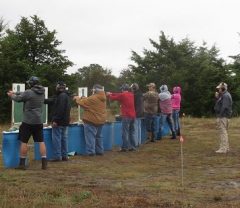Marksmanship, like any other skill, requires practice, but especially the right kind of practice. You can throw a football with two hands, but the result won’t be great. One-handed is the preferred way, but depending on the skill, best practices are not always intuitive.
In pistol shooting, there is a standard set of fundamentals: stance, grip, aiming, breath control, trigger control, and follow-through. Many shooters are self-taught, so they may not be aware of all of these, or may think some of them are not important. In fact, many shooters will achieve a reasonable skill level without paying attention to some of these, like stance or follow-through, which seems to reinforce the idea that they are just concept names. The fact is, they are all important, but with varying weights.
If you have a mutual fund, your money is invested in different stocks, but with exposure based on risk. More money is invested in stocks with low risk, and less in those with higher risk. They are all important, but have different roles in your portfolio.
And so it is with shooting. All the fundamentals are important, but some are of maximum importance. As a pistol instructor, I often see students fall short in their goals/expectations, and nearly always for one (or both) of two reasons: aiming, and trigger control.
- Aiming. I have caught students looking over the barrel of the gun, and not through the sights. No good. Sometimes the front and rear sights are not aligned properly (horizontally and vertically). Also no good, although sometimes that will seem to work at a very close distance. The biggest issue, probably, is focusing the vision (the focal point) on the target instead of the front sight. That is not intuitive to most new shooters, and again, will often work at a close distance. I have seen shooters hit center mass at 3 yards, yet be unable to hit anywhere on the paper at 7 yards, just because of that.
- Trigger Control. This is probably the most common problem I see: jerking the trigger. Most newer shooters don’t understand how critical it is for the muzzle to not move at all as the trigger is moved to the rear. For safety reasons, most guns don’t have a hair trigger; a certain amount of force is required to overcome the trigger spring, and to disengage the sear so the gun will fire. If you are too ham-fisted with that, the muzzle will be pulled off target, and even a hair’s-width will make a big difference. I tell students to take up the slack (take-up) in the trigger, and squeeeeeze slowly (1.5 sec) until the gun fires, and don’t anticipate or react to recoil. Torque on the trigger must be evenly balanced, left and right. With experience, that 1.5 sec can come down to 1 sec or less, but it will never be 1/10 sec. Get over it; this is not the movies.
Make those two fundamentals the centerpiece of your practice regimen, then polish with the other four, and you will see good results.
